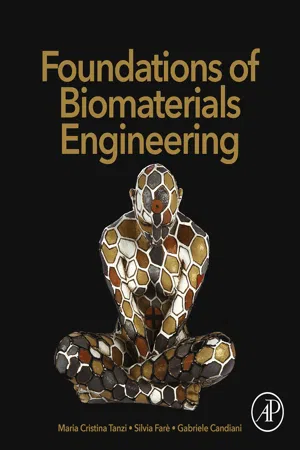This chapter intends to give an overview of the main (bio)materials used in the medical field, in particular for the manufacture of devices and prostheses.
Before starting with the different types of biomaterials, it is appropriate to provide the definition of biomaterial and related concepts.
4.1.1 Biomaterial
It is difficult to give a concise and unambiguous definition of biomaterial, as the elements to be taken into account are manifold. Over the years, different definitions of biomaterial have been given, and presently the main organizations (e.g., the American National Institute of Health (NIH)) and associations of the sector are inclined toward some specific definitions, reported in the following sections.
According to the Miller-Keane Encyclopedia & Dictionary of Medicine, Nursing, and Allied Health, 7th Edition (© 2003 by Saunders, Elsevier Inc.), a biomaterial is: “any substance (other than a drug), synthetic or natural, that can be used as a system or part of a system that treats, augments, or replaces any tissue, organ, or function of the body; especially, material suitable for use in prostheses that will be in contact with living tissue.” This definition is substantially similar to the one employed by NIH.
According to the Segen's Medical Dictionary (© 2012 by Farlex, Inc.), the definition covers two aspects: “(1) Any synthetic material or device—e.g., implant or prosthesis—designed to treat, enhance or replace an aging, malfunctioning, or cosmetically unacceptable native tissue, organ, or function in the body; (2) A native material used for its structural, not biological, properties—e.g., collagen in cosmetics, carbohydrates modified for biomedical applications, or as bulking agents in food manufacture.” This definition is almost similar to that reported by the McGraw-Hill Concise Dictionary of Modern Medicine (© 2002 by The McGraw-Hill Companies, Inc.).
Another definition of biomaterial endorsed by a large consensus of experts in the field (European Society of Biomaterials, Satellite Consensus Conference, Sorrento, 2005) is: “A material intended to interface with biological systems as an integral part of a process designed to evaluate, monitor, or treat tissues of the body, to replace or augment tissues, or to facilitate the regeneration of tissues.”
As a science, “biomaterials” is about 50 years old. In the modern era, the study of biomaterials, called “biomaterials science” or “biomaterials engineering,” is marked by a high degree of interdisciplinarity, encompassing elements of medicine, biology, chemistry, tissue engineering, and materials science.
Although the introduction of materials into the human body took place throughout history, the word biomaterial was not known, and just 60 years ago biomaterials, as we think of them today, did not exist.
Ancient Egyptians used linen threads to close wounds as long as 4000 years ago, and Europeans used sutures made from catgut in the Middle Ages. However, the use of materials to repair the body prior to the era of modern medicine was not limited to sutures. Incas regularly repaired cranial fractures with gold plates; Mayans used seashells to create artificial teeth; and early Europeans shaped artificial teeth out of iron 2300 years ago. Nevertheless, early attempts at using materials in the body were rather hit-and-miss. Because of a poor understanding of biocompatibility and sterilization, even most implants before the 1950s had a low probability of success, and only in recent times scientists have begun to systematically examine interactions between the body and materials.
4.1.2 Biocompatibility
According to The Williams Dictionary of Biomaterials (Williams, 1999), “Biocompatibility refers to the ability of a material to perform with an appropriate host response in a specific application.”
Although this definition seems ambiguous at a first glance, it represents a huge step forward from the prevailing opinion at the time of its introduction that successful materials should play inert roles in the human body.
More specifically, biocompatibility can be defined as the “ability of a biomaterial to perform its desired function with respect to a medical therapy, without eliciting any undesirable local or systemic effects in the recipient or beneficiary of that therapy, but generating the most appropriate beneficial cellular or tissue response to that specific situation, and optimizing the clinically relevant performance of that therapy.”
The biological response is the local and systemic response of the host organism to the implanted biomaterial or device. Examples of appropriate host responses include resistance to blood clotting, resistance to bacterial colonization, and normal, uncomplicated healing. In this context, the evaluation of biological responses is a measure of the magnitude and duration of the adverse alterations in homeostatic mechanisms that lead to the host response. Practically speaking, the evaluation of biological responses is carried out to determine that the biomaterial performs as intended and presents no significant harm to the patient or user, with the aim of predicting whether a biomaterial presents potential harm to the patient or user by evaluating conditions that simulate clinical use (Anderson, 2001).
This definition offers no insights the mechanisms of biocompatibility, how to test the biocompatibility of a material, or how to enhance or optimize the biocompatibility of a material.
Another important aspect to be considered is the difference in biocompatibility requests between a long-term implantable device and a structure (scaffold or matrix) to be used for tissue regeneration:
Biocompatibility for long-term implantable medical devices. “Ability of the device to perform its intended function, with the desired degree of incorporation in the host, without eliciting any undesirable local or systemic effects in that host” (ESB, Satellite Consensus Conference, Sorrento, 2005);
Biocompatibility for scaffolds or matrices for regenerative ...
